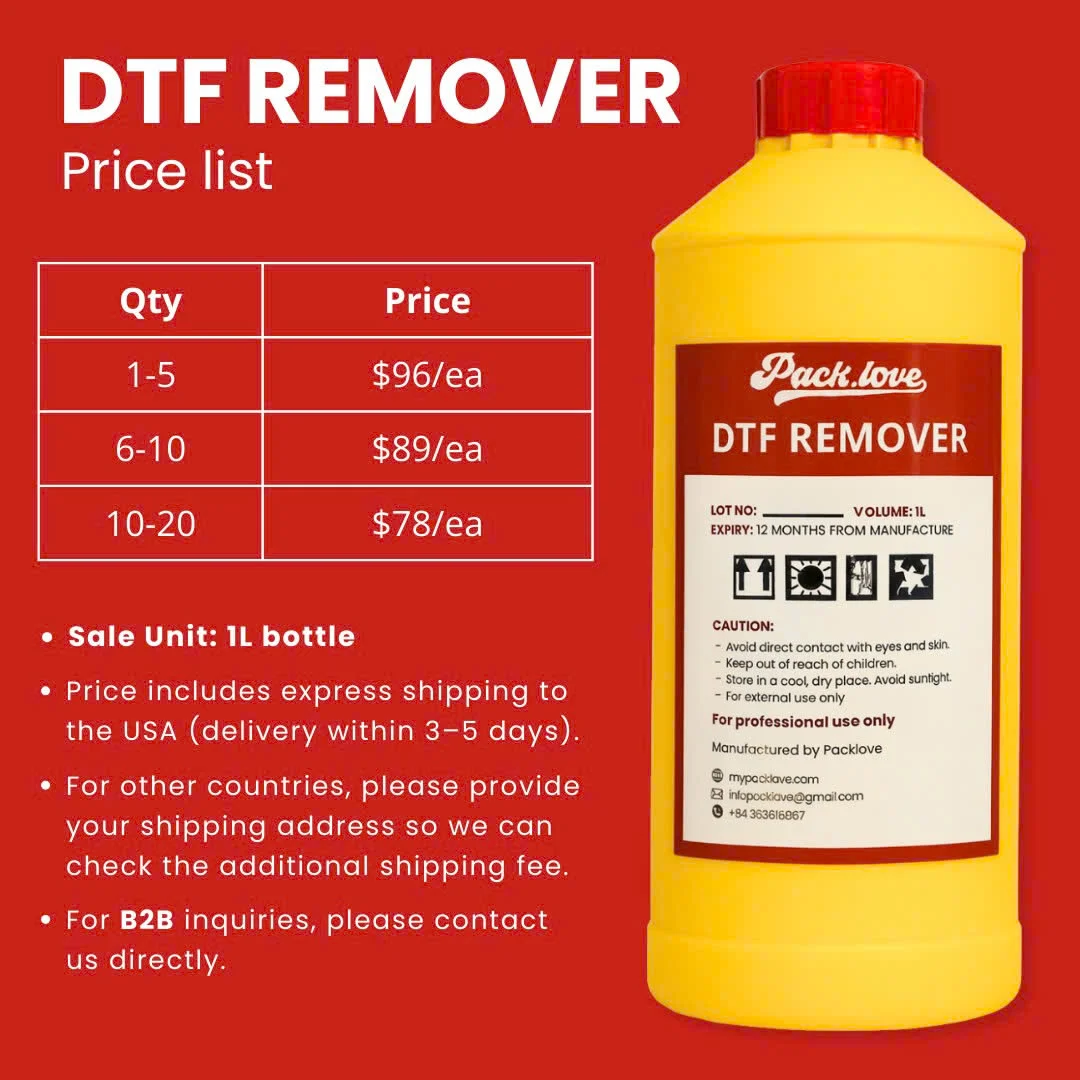Understanding Pleats in Clothing: Essential Business Guide
Pleats represent a fundamental element in clothing design and construction, shaping garments and adding visual interest. For small apparel businesses navigating the world of fashion production, a clear understanding of pleats – from their definition to their application – is essential.
This practical guide explores the various aspects of pleats, offering valuable insights into how these fabric manipulations influence garment fit, function, and style. Delving into this topic equips businesses with the knowledge needed to make informed decisions about fabric choices, design features, and garment construction, ultimately contributing to the quality and appeal of their clothing lines.
1. What exactly is a pleat in fabric and clothing?
At its core, a pleat is a deliberate, structured fold in fabric. The creation involves doubling material over on itself and securing the fold, often through stitching or pressing (applying heat and pressure). This is a specific sewing technique used for fabric manipulation, distinguishing pleats from accidental wrinkles or gathers. Their primary function within a garment is often to manage fullness, add decorative detail, or improve the overall fit.
A key distinction exists between:
- Pressed pleats: These feature sharp, defined creases, typically set using heat or steam. Pressing creates crisp lines that hold their shape well, contributing to a more structured appearance.
- Unpressed pleats: These folds are softer and more rounded, lacking the sharp crease of pressed pleats. They offer a gentler drape and volume without the defined structure.
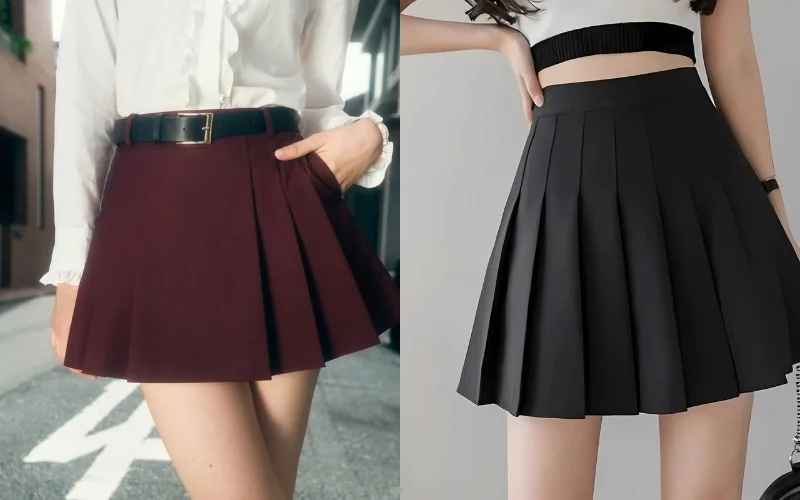
2. The purpose of pleats: Why use them in garments?
Pleats serve both functional and aesthetic roles in garments. Understanding their purpose helps clarify why designers incorporate them into various clothing design elements.
- Adding fullness and volume: Pleats are a primary method for expanding the width of a fabric panel beyond its flat measurement. This technique creates volume, commonly seen in skirts where multiple pleats transform a straight piece of material into a flared shape attached to a narrower waistband.
- Allowing freedom of movement: Certain pleats are strategically placed to provide necessary ease without altering the main silhouette. Kick pleats at the hem of narrow skirts or coats allow for comfortable walking. Similarly, pleats on the back of jackets provide room for shoulder and arm movement. Pleats in trousers also contribute to comfort during motion.
- Creating style lines: Pleats can function purely as decorative elements, contributing visual interest and specific style lines to a garment’s design. Their direction, size, and placement can significantly alter the aesthetic appeal.
- Improving fit and gathering fabric: When joining a wider piece of fabric to a narrower one (like attaching a full skirt to a waistband), pleats offer a structured way to control and reduce the excess fabric. This method provides a neater, more tailored finish compared to simple gathering, which creates softer, less uniform folds.
3. Common types of pleats every clothing business should recognize
While numerous pleat variations exist through intricate fabric manipulation, recognizing a few core types is fundamental for any clothing business. Familiarity with their visual appearance and typical application in a garment is key.
3.1. Knife pleats: The versatile basic
The knife pleat is characterized by its simple, directional fold. All folds face the same way, creating a series of overlapping layers.
- Construction: Each pleat is made by folding the fabric over itself in one direction.
- Appearance: Typically pressed for sharp creases, knife pleats create clean, parallel lines and lay relatively flat against the body or underlying fabric layer.
- Common uses: Frequently used for skirts (especially school uniforms and traditional kilts), dresses, and sometimes as detailing on blouses or sleeves. Can be used as an alternative to gathering for controlling fullness.
- Fabric usage: Often requires a 3:1 ratio – meaning three units of fabric width are needed to create one unit of finished pleated width.
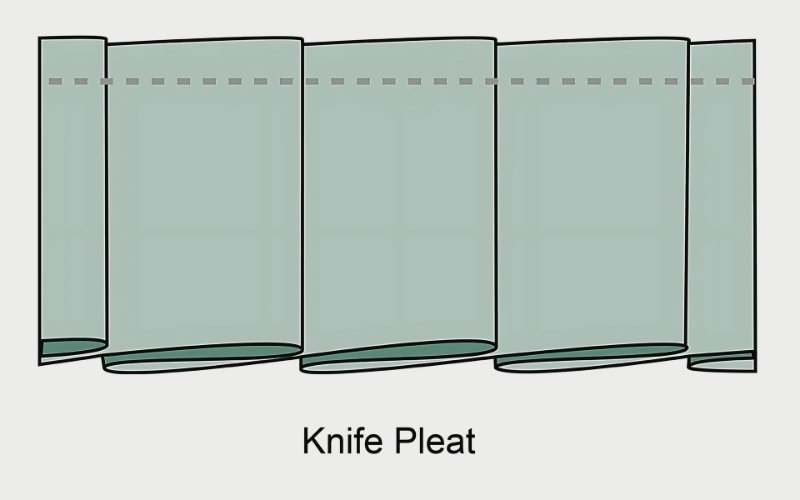
3.2. Box pleats: Creating structured fullness
A box pleat is formed by two knife pleats folded away from each other, with their back folds meeting underneath.
- Construction: Two parallel fabric folds face opposite directions on the surface, creating a ‘box’ shape between them.
- Appearance: Creates structured fullness and more volume than knife pleats. Box pleats tend to spring outwards from the seam or waistline.
- Common uses: Popular for skirts requiring significant volume, jumper dresses, and often seen as a single pleat on the back yoke of shirts and some jackets for ease of movement.
- Variations: Can be stacked (double box pleats) for even greater fullness, although this adds bulk to the seam.
3.3. Inverted box pleats: A subtle variation
An inverted box pleat is essentially the reverse configuration of a standard box pleat.
- Construction: Two knife pleats are folded towards each other so their edges meet at the center line on the garment’s exterior. The main fold and volume are concealed underneath.
- Appearance: Presents a flatter appearance on the outside compared to a box pleat, while still providing underlying fullness and ease. The visual effect is a seam line flanked by two parallel folds pointing inwards.
- Common uses: Frequently used in skirt panels (often at the center front or back), below yokes, or sometimes as the structure for kick pleats.
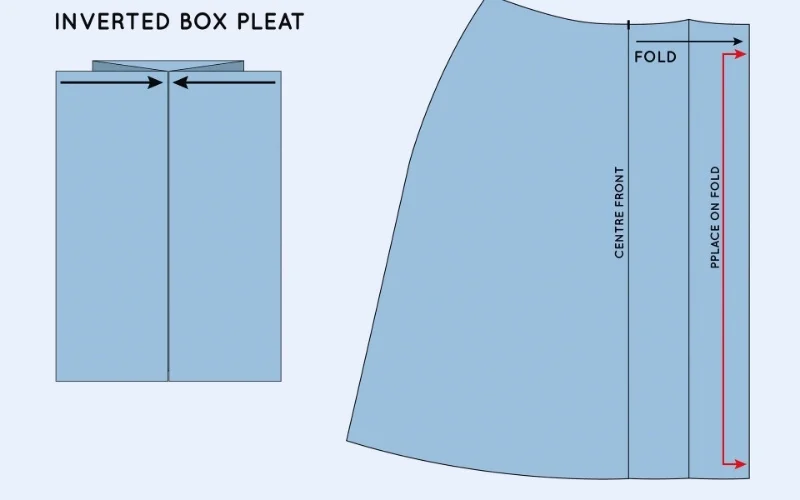
3.4. Accordion pleats: Dynamic and textured
Accordion pleats consist of a series of narrow, parallel folds of equal width, resembling the bellows of an accordion.
- Construction: Created through specialized pleating processes, often involving heat-setting to ensure permanence, especially with synthetic material. The folds alternate direction sharply.
- Appearance: Known for their distinct textured surface and dynamic movement. They create significant expansion and contraction capabilities in the fabric. Often pressed very sharply.
- Common uses: Widely used in flowing skirts and dresses, decorative trim, some blouses, and collars or cuffs.
- Note: The famous Fortuny pleats, developed by Mariano Fortuny, are a highly specialized, fine form of accordion pleating in silk, known for their unique texture and drape.
3.5. Kick pleats: Functional and discreet movement
A kick pleat is a short pleat, typically located at or near the hem of a garment.
- Construction: Usually structured as an inverted box fold or sometimes overlapping knife pleats, starting partway up from the garment’s bottom edge.
- Function: Its primary purpose is to allow ease of movement (like walking or sitting) in otherwise straight or narrow garments, such as pencil skirts or fitted coats, without adding fullness at the waist or hips.
- Appearance: Designed to be functional and relatively discreet when the wearer is stationary.
4. Where you’ll typically find pleats in apparel
Understanding the common placements of different pleats in apparel helps in identifying garment styles and appreciating their construction. Various types of clothing utilize pleats in specific areas for functional or aesthetic reasons.
4.1. Skirts and dresses
Skirts and dresses are perhaps the most common garments featuring pleats.
- Waist/hip: Knife pleats, box pleats, and accordion pleats frequently originate from the waistband or hip line to create varying degrees of fullness and shape in the skirt portion. Knife pleats can produce an A-line silhouette, while box pleats contribute to a fuller, more structured look. Accordion pleats offer maximum fluidity and movement.
- Hem: Straight or fitted skirts often incorporate kick pleats at the back or sometimes side hem to allow for easier walking.
4.2. Trousers
Pleats in trousers are typically found at the front, just below the waistband.
- Types: Forward pleats have the fold opening towards the center front (fly), while reverse pleats have the fold opening towards the side pockets.
- Purpose: They provide extra room and comfort around the hips and thighs, particularly when sitting, and contribute a specific style aesthetic compared to flat-front trousers.
- Popularity: The popularity of pleated trousers varies with fashion trends.
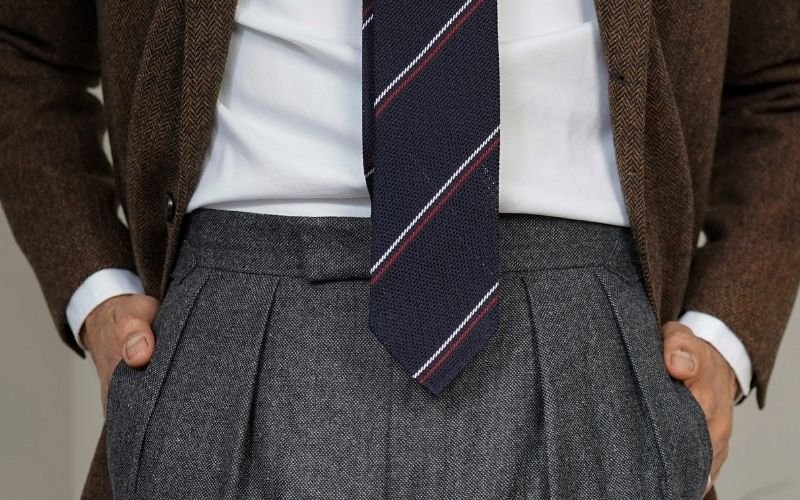
4.3. Shirts, blouses, and jackets
Pleats also appear in upper body garments.
- Back yoke: A common feature on the back of men’s shirts and some women’s blouses and jackets is a central box pleat or two side knife pleats extending down from the yoke seam. These provide crucial ease for shoulder and arm movement.
- Sleeves: Small pleats are often used where the sleeve fabric tapers into the cuffs, neatly managing the fabric fullness.
5. Considerations when working with or choosing pleated garments
For businesses sourcing, designing, or selling pleated garments, several practical factors warrant consideration:
- Fabric choice: The type of fabric significantly impacts how well a pleat forms and holds its shape. Heavier material like wool or sturdy cotton can maintain a sharp crease after pressing (knife or box pleats). Lightweight fabrics like silk or chiffon create softer, drapier pleats. Synthetic fibers are often essential for permanent, heat-set accordion pleats. The chosen fabric must suit the intended pleat type and desired silhouette.
- Desired silhouette: The type of pleat directly influences the garment’s overall shape. Knife pleats offer controlled fullness, box pleats provide more structured volume, and accordion pleats create significant texture and flow. Consider how the pleat style contributes to the intended design aesthetic and fit.
- Care instructions: Pleated garments often require specific care. Pressed pleats may lose their sharpness with washing and might need professional dry cleaning or careful ironing along the original fold lines to maintain their appearance. Unpressed pleats are generally lower maintenance. Providing clear care instructions are vital for customer satisfaction and the longevity of the garment.
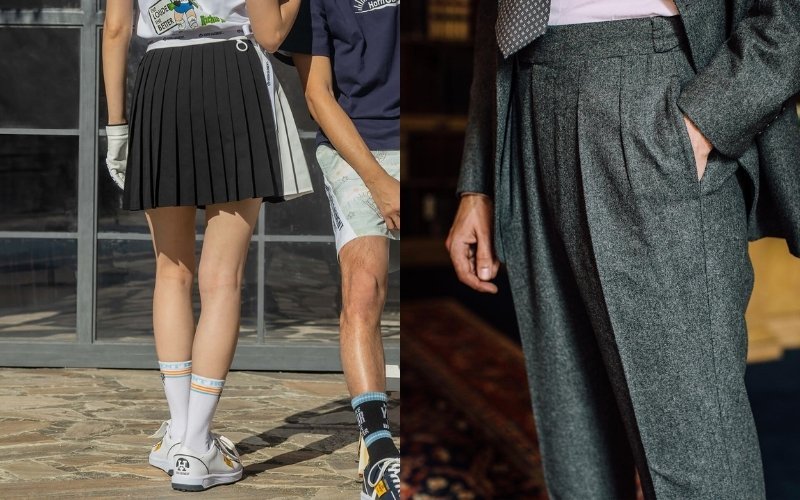
6. Related questions
6.1. What is the difference between pleating and gathering?
Pleating involves creating structured, measured folds in fabric, resulting in regular, defined shapes (like knife or box pleats). Gathering, conversely, involves drawing fabric together along a stitch line, creating softer, smaller, less uniform folds or ripples to control fullness. Pleating generally offers a more tailored appearance than gathering.
6.2. How do you care for pleated clothing?
Always consult the care label first. Garments with crisp, pressed pleats often benefit from professional dry cleaning to preserve the creases. For less structured pleats or washable fabrics, gentle hand or machine washing (if permitted) followed by hang drying is usually best. If ironing is needed, use the appropriate heat setting for the fabric and carefully press along the existing fold lines. Avoid stretching the pleats while damp.
6.3. Are pleats suitable for all body shapes?
Pleat placement and type can influence how a garment visually fits different body shapes. For instance, pleats starting lower on the hip might add less perceived volume at the waist compared to pleats beginning directly at the waistband. Wider pleats can add more visual width than narrow ones. However, personal preference and overall garment styling play significant roles, so offering variety is often beneficial.
6.4. Can any fabric be pleated?
While most fabrics can technically be folded, their ability to hold a pleat varies greatly. Fiber content, weave structure, and weight are crucial factors. Wool and certain synthetics hold pressed pleats well. Synthetics are particularly suitable for heat-setting permanent pleats (like accordion pleats). Lightweight or loosely woven fabrics may not retain sharp folds without specific treatments or construction techniques.
Read more:
In summary, pleats are far more than simple folds; they are versatile sewing techniques fundamental to apparel construction and design. These structured manipulations of fabric serve critical functions, providing movement and improving fit, while also offering significant opportunities for enhancing style and creating unique silhouettes.
Understanding the common types – such as the knife pleat, box pleat, accordion pleat, and kick pleat – and their typical applications is invaluable knowledge for any clothing business involved in garment creation or curation. Mastering these concepts allows for better communication with manufacturers, more informed design choices, and ultimately, products that better meet customer needs. For businesses seeking further support, especially with specialized aspects like labeling or packaging for unique apparel lines, resources like Packlove offer expert guidance.






